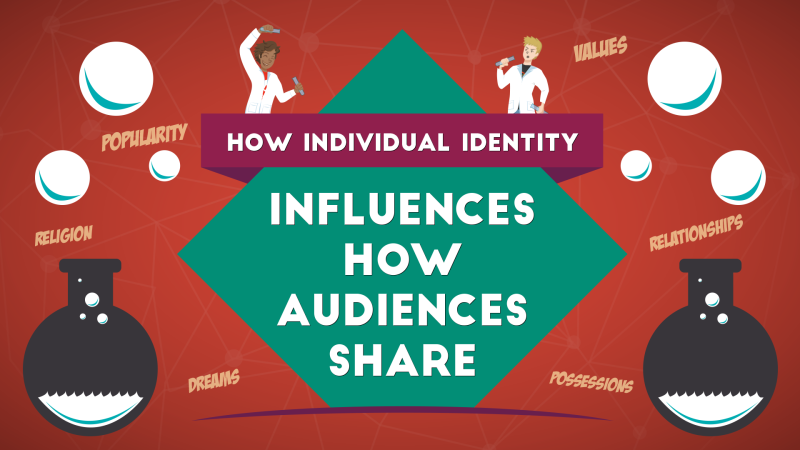How individual identity Influences the way Audiences Share [Survey Data]
What motivates us to share content? Contributor Kelsey Libert delves right into a up to date learn about by means of Fractl detailing how and why we share on social media.
aspects Of id
Our survey inquisitive about the five huge elements that make up particular person identities, as identified by using social scientists. they are:
- private – when it comes to values, desires, goals, and feelings
- Relational – when it comes to relationships, dedication to companions, and shut friendships
- Social – in terms of recognition, reactions from others, and bodily appearance
- Collective – relating to one’s era, race, and religion
- Superficial – when it comes to issues one owns, age, and gender
while each and every of those categories goes into a person identity, they’re not all essentially equally essential. In his paper, “id Salience and identification importance in id thought,” Dr. R.C. Morris of Purdue university explained that in line with id theory, we rank the various elements of our identities in a hierarchy. the higher an identification is ranked, and the higher and extra important the social community related to that id, the extra possible it’s that we will be able to take action to toughen or fortify that identification. So, which identities are most essential to customers on social networks? On a scale of 1–5, survey participants ranked their relational and private identities as most important to them when sharing content material on social media. 
Relational identity
when it comes to sharing content material online, 84% of all individuals mentioned “relationships” and “being a excellent buddy to these I care about” are necessary to them. more than 20% stated these components are “extremely essential,” giving them the absolute best that you can imagine rating. Relational identities were the most important to the oldest age staff in our learn about; those in the 65+ age class ranked their relationships with others much greater than every other issue in the survey.
non-public identification
This facet of identification includes an individual’s interior lifestyles, beliefs, creativeness, and emotions. On average, survey participants ranked this category 2nd-most necessary to their sharing habits; 63% of contributors ranked their personal values and ethical standards as very or extremely necessary when they shared content on-line. We additionally discovered that younger individuals rated this non-public aspect of id fairly higher, and its importance diminished because the age groups become old. each youthful and older Millennials (ages 18–34) ranked their desires, creativeness, and objectives greater than their older counterparts.
Social identity
Social identity – involving recognition, reactions from others, and bodily appearance – used to be the 0.33 most essential to all members. men tended to rank this side somewhat higher than girls, with 41% of fellows pronouncing recognition used to be at least fairly important, compared with 37% of ladies. youthful participants, including Millennials and generation Xers (a long time 18–50) positioned extra significance on their bodily appearance, whereas the oldest age groups (ages fifty one and above) gave it little or no significance. 
Superficial identification
Most contributors said they did not care much concerning the superficial factors of their id online. subject matter possessions, age, and gender ranked 2nd-lowest in our survey. Fewer than 30% mentioned their sex or age was essential. this may occasionally mirror the truth that the most superficial factors of our identities are additionally the perfect to conceal on the net. Fewer than 35% said their possessions — the issues they own — had been essential of their content material sharing. on the other hand, men and younger respondents ranked possessions higher than different groups, with 31% of youthful Millennials, 16% of older Millennials, and 16% of fellows ranking possessions as “very” or “extremely” important.
Collective identification
factors when it comes to generation, race, and faith ranked as the lowest issues in online sharing behavior. Fewer than 10% of all members ranked any collective identity factor as “extremely important.” Older customers – those over the age of 35 – ranked being a member of their technology larger than youthful users, with child Boomers ranking this factor most highly. This displays the truth that older generations are extra probably to be aware of generational shifts in values.  The least necessary issue that users believe when sharing content material online? faith. fifty five% of survey respondents mentioned this factor was once “not essential.”
The least necessary issue that users believe when sharing content material online? faith. fifty five% of survey respondents mentioned this factor was once “not essential.”
Sharing behavior
Our survey confirmed that social media use was popular and ubiquitous across all age groups. greater than eighty five% mentioned they posted on social media at least as soon as a week. 68% of members mentioned they’d posted on social media between 1–7 instances in the past week. forty two% stated 1–3 of their posts had been articles or media from 0.33-party on-line publishers. noticeably, these within the youngest technology (age 18–21) were least likely to share on social media; 21% of that age crew mentioned they hadn’t posted in any respect previously week, and 53% said they’d no longer shared content material from any online publishers. The oldest respondents (ages 65 and above) have been the subsequent least prone to share third-birthday party content; 50% said they hadn’t shared content material from publishers prior to now week. men reported sharing more often on social media than ladies. however ladies are expecting more engagement from their pals: 68% of ladies predict eleven or extra likes or feedback on their fb posts, when put next with sixty one% of fellows. similarly, child Boomers (ages forty one–sixty five) mentioned they predict extra engagement from their chums than other age groups did. more than 30% of older Millennials and those age 51 and older predict to obtain 11 extra likes or feedback, when compared with less than 1 / 4 of younger Millennials and Gen Xers. but, receiving fewer than the expected amount of likes or comments does not considerably impact whether users will reshare an identical content material, our survey discovered. Eighty-9 p.c (89%) of ladies and 87% of fellows mentioned there used to be as least some likelihood they would post similar content sooner or later, and nearly 10% of each women and men mentioned they “undoubtedly will,” regardless of engagement. in a similar fashion, child Boomers have been more possible than other age groups to share equivalent content again, regardless of engagement. 
Motivations For Sharing
when we asked individuals to rank their most vital motivation for sharing on social media, one resolution dominated all others: they want to entertain. forty four% of respondents ranked entertainment as their top motivation for sharing, adopted via schooling in 2d at 25%. The 0.33 most necessary motivation for sharing was once “to share one thing that could be a reflection of who i am,” which used to be most essential to twenty% of users. very few (about 10%) mentioned they shared content as a way to “show make stronger for a cause.” And the motivation “to find out about folks” on the social network barely registered as vital with any respondents. Motivations for sharing different somewhat by using gender. basically, women share more altruistically than men. Of the final five articles they shared, 44% of ladies and 27% of guys shared content to indicate their improve for a cause. on the other hand, most effective thirteen% of women and 8% of fellows said altruism used to be “most essential” to them once they shared content material. in a similar fashion, younger people tended to place the least importance on displaying give a boost to for a result in. Fewer than 10% of all respondents below the age of 50 ranked reasons as vital, whereas that number jumped to twenty% for a long time fifty one-65 and 37% for a while 65+.
Conclusion
once we asked customers about sharing explicit articles, they were a long way more more likely to share essentially the most pleasing and least personal content material. on the same time, they were least likely to share content with the absolute best doable controversy, moral valence, or value judgments. The social factors of social networks (relationships, being a excellent friend) dominate individuals’s use of social media, they usually determine most prominently into people’s motivations for sharing 0.33-celebration content. The extra individualist factors of non-public id (personal goals and hopes, creativeness) rank decrease, but they are still important drivers of social media shares. the most particular and superficial categories (race, gender, religion) have the least effect on extensive sharing habits. So users are keenly conscious that the usage of social media is a primarily social act that involves folks and is likely to impact others. Their most preferred effect is to entertain – with the aid of a ways essentially the most dominant motivation for sharing – adopted by using education. These, too, are the most social motivations for sharing – they inherently have an effect on others. As social media permits user to construct their identity, customers are mindful that it is an inherently social identification. users appear to want to undertaking an open, humorous, welcoming, and enjoyable persona – and are on the lookout for content material to lend a hand them reach that goal.
advertising Land – web advertising news, methods & guidelines
(291)

![How individual identity Influences the way Audiences Share [Survey Data]](https://www.devicedaily.com/wp-content/uploads/2014/11/Individual-Identity_1-800x450-520x292.png)











